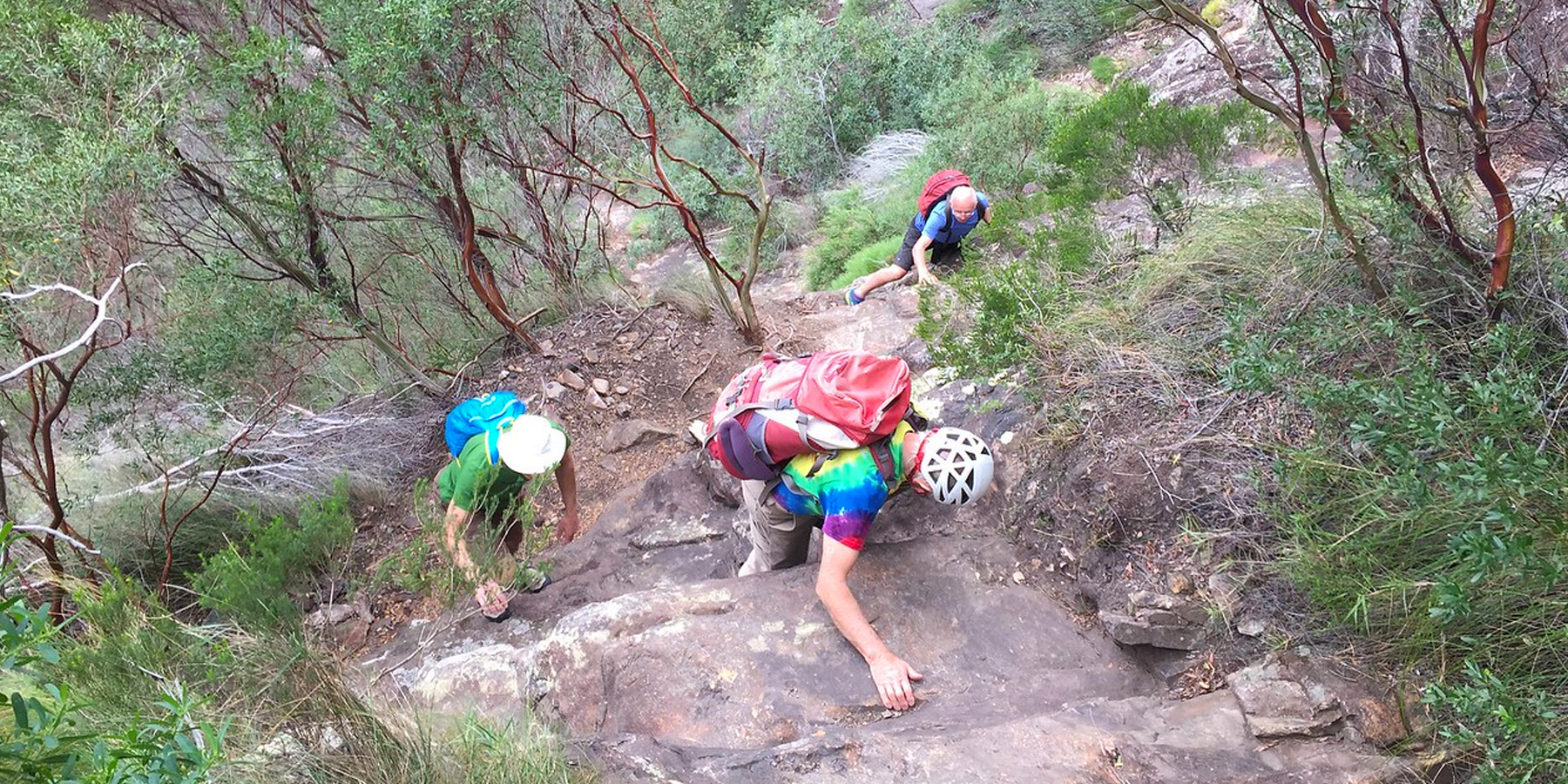
Mark Squires (www.markwsquires.photos)
Scrambling
The textbook definition of scrambling is somewhat ambiguous. It reads,
a walk up steep terrain often involving the use of one’s hands
In reality, scrambling is an activity that exists somewhere between hill walking, rock climbing, and easy mountaineering. Scrambling is the natural transition that occurs when a walker comes to a steep, rocky obstacle and decides to climb up it instead of going around it. Scrambling also involves descents and traverses.
A lot of scrambling routes require no additional equipment or even a change in footwear. However, more demanding scrambles may need safety ropes, and it’s usually a good idea to wear a climbing helmet to avoid injury from falling rocks.
Ascending or descending steep, rough and/or rocky terrain and requiring the use of hands as well as feet. In some cases a rope may be used to assist in difficult or potentially dangerous situations. Scrambling can range from relatively easy short sections to long, difficult, exposed and dangerous ascents/descents verging on rock climbing. Walkers should think about their ability and experience when considering walks that involve scrambling.
6 Basic Scrambling Skills
Source: Trail Hiking Australia
Scrambling over easy rock terrain uses the same movement skills as rock climbing. Many rock climbers actually learn how to climb by scrambling up mountains. They learn about keeping in balance and using precise footwork by moving over slabs, by finding handholds and footholds on steeper cliff sections, and by hopping across loose boulders. Later they take those movement skills and use them to become actual rock climbers.
Here are six basic climbing movement skills that will improve your scrambling, getting you up more mountains and staying safer when you’re climbing easy rock without equipment and a safety rope.
1. Stay in balance.
Always keep three points of contact—two feet and a hand or two hands and a foot—on the rock surface at all times. Move only one limb at a time. Stay solid as you move. Make moves from your body’s core to keep in balance.
2. Keep weight over your feet.
When you’re scrambling you’re usually on easy rock terrain so you can almost always find secure footholds. Use those footholds to stay in balance. Learn to trust your feet. Use the biggest holds whenever possible. Keep your weight over your feet, not on your arms.
3. Use your hands effectively.
Don’t make long reaches with your arms. Instead grab handholds that are no higher than a foot above your head. If you’re scrambling on slabby or low-angle terrain and don’t need handholds, spread your arms out for balance like you’re walking a slackline. Learn all the basic finger grips so you can utilise lots of different handholds.
4. Test all handholds and footholds.
Loose rock abounds on scrambling routes. Test every handhold and foothold that you use. Pull down on handholds rather than out. Tap the rock around handholds with your knuckles. If it sounds hollow—don’t use it. Loose rock causes many scrambling accidents.
5. Load your climbing pack correctly.
Put all the heavy stuff at the bottom of your climbing pack and close to your back, which lowers your center of gravity and makes you less likely to tip backwards. A waist strap keeps your pack from shifting during crucial moves and throwing you off balance.
6. Stay focused.
Scrambling is dangerous. If you are climbing easy rock terrain without a rope, then a misstep, broken hold, or loss of focus could cause a fatal fall. Keep your attention on the climbing moves ahead. Don’t get wrapped up in conversations with your hiking buddies or daydreaming about your next hike. If you’re out of breath in high mountains, stop and catch your breath in a safe spot. If you’re gripped by exposure, the gaping void of air beneath you, stop at a safe place like a ledge and take a few deep breaths. Never be afraid to ask a hiking buddy for help if you’re having problems or if you’re scared. It’s better to be safe than to risk a fall.
Articles & Resources
Scrambling is the perfect way to make a bushwalk more exciting and adventurous. Find out all you need to know about scrambling in this guide… in fact if you walk in the hills regularly then you’ve probably already been scrambling – you just didn’t realise it. Scrambling describes the middle ground between walking and climbing, and it’s a feature of many of the best bushwalks.
https://www.livefortheoutdoors.com/hiking/advice/beginners-guide-scrambling
Source: Live for the Outdoors
Take your mountain trail walking off-piste with these nine tips from expert scramblers.
https://www.redbull.com/us-en/beginners-guide-scrambling-tips
Source: Red Bull

Most hikers are already familiar with the term scrambling; it’s arguably the best way to prepare your breakfast eggs after a night in a tent. For that reason, you may see or hear the term “rock scrambling” so you can differentiate.
As this article is about how to rock scramble, be assured that whenever you see the term scrambling, we’re not talking about your morning repast but a bonafide outdoor activity! Read More
Source: Cool of the Wild
Scrambling is a very natural activity, and the techniques are easy to master, but you will need a head for heights. Some easy scrambles still involve exposed sections, where you are right next to long drops. This means that scrambling is a potentially dangerous activity. Still, most risks can be eliminated with careful planning, appropriate route selection, the right gear, and plenty of common sense.
So, if you want to take hiking to the next level but don’t want to resort to rock climbing or mountaineering, scrambling could be the perfect next step.
Discover
Search for scrambling providers in Discover
(search on ‘scrambling’ in Select Activity)
Recommend a Resource
Have an interesting or useful resource or link to share?
Let us know by Recommending a Resource



